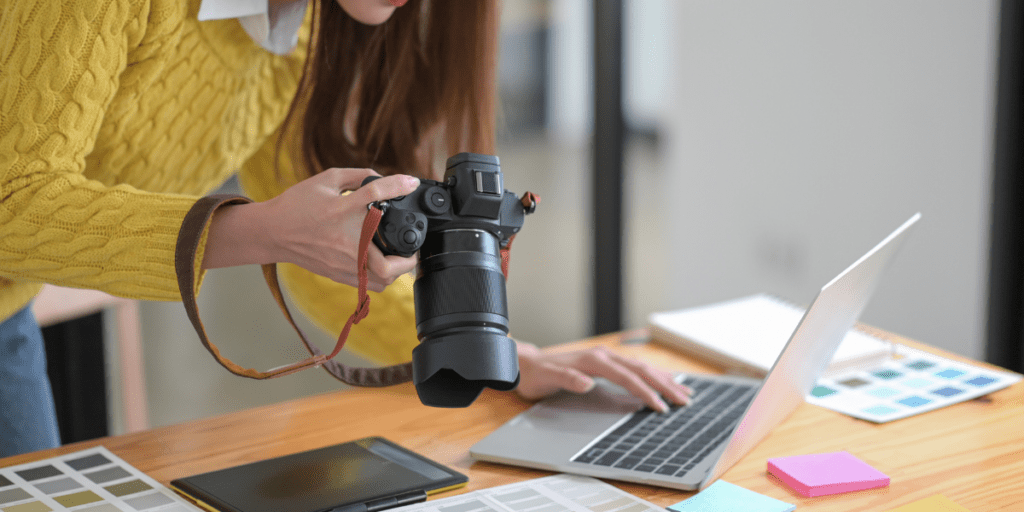Some experts know how AI algorithms work.
A few highly specialized professionals.
However, most people (including myself) perceive AI tools as magic. We click the button, get the result, and have no idea what happens in the meantime.
It doesn’t have to be this way. Today, we’re going to demystify AI by explaining how online passport photo algorithms work.
Ready to explore artificial intelligence secrets?
From Your Selfie to Document Picture
Firstly, let’s take a look at how the entire process works generally.
The first step of the passport photo app is to guide you in taking the perfect picture. It’s not so easy! You have a few requirements to meet: you can’t smile, you have to look straight into the lens, your eyes must be open, and your mouth must be closed. You should ensure your face is well-lit to prevent shadows. Having your face in the center of the picture is ideal.
So many things to keep under control, huh?
But do not worry; the purpose of the app is to direct your posing and assist you in meeting all of these requirements. Most tools describe the process in a simple and informative manner. They also display reminders, which make it easier to keep track of all the information. Finally, some apps, like PhotoAiD, display the shape of the head during the photo-taking process to help you position your face correctly.
Once your photo is ready, you can upload it to the app. Then, the AI algorithm makes its *magic* which we’ll explain soon. Finally, the improved picture is checked by human experts to ensure approval.
As a result, you receive a proper document picture that is edited properly and meets all government requirements.
But what happens backstage?
Background Removal
Can you recall your last visit to an onsite photographer?
Now, think. Can you recall the background against which your picture was taken?
Exactly.
All document pictures need to have a white, solid background. However, we do not necessarily have this option when taking a headshot at home. So, here, machine learning algorithms come in handy.
First, AI tools analyze your photo. The algorithm recognizes the edges of your face and hair. Usually, it works based on color differences, so a background that is patterned or in a color similar to your hair can be a challenge! That’s why experts work on improving algorithms. They must train them to be sensitive and cautious enough to avoid leaving the background or removing a part of your head.
Identifying your body contours is the main challenge. Once it’s done, the app erases the background and replaces it with a white, solid one.
This way, your photo gets a plain background, which passport offices require.
Cropping the Image
The proper background is not everything. US passport guidelines also specify the dimensions of passport photos.
It might be difficult to prepare the photo in the appropriate size, including what percentage of the image should be taken up by your head. Luckily, any AI passport photo tool is filled with all the information on the sizes that the authorities require. It automatically resizes your picture.
But it not only crops the image to the right size, it also places your face in the center and checks the border space. After all, AI tools are famous for their attention to detail!
Almost like Photoshop – Minor Edits
The document photo tool will not delete your wrinkles. But it will still take care of making you look better – at least according to official requirements.
Your appearance is not a concern for the AI tool. It pays attention to lighting, sharpness, and contrast. Usually, it works by comparing the colors of adjacent pixels in the image. This way, it can recognize shadows on your face, which are not allowed. It also aids in the detection of minor facial flaws (pimples, small moles, and so on).
The challenge for AI in this case is to recognize your eyes, mouth, brows, and nose and not treat them as artifacts to be removed!
Once it’s done, the AI tool balances colors. The goal of AI is to keep pixel colors as similar as possible. As a result, your skin looks smoother, and shadows are removed.
Well, even if algorithms do not care how you look, they can still make you look better.
Final thoughts
Background removal, cropping the image, and shadow editing – those are three things you can successfully forward to AI. As a result, you save time on manual editing and get your passport photo quickly.
Although there’s some magic involved, isn’t there?
